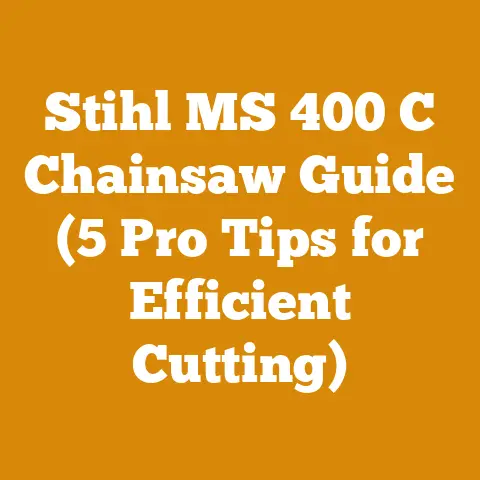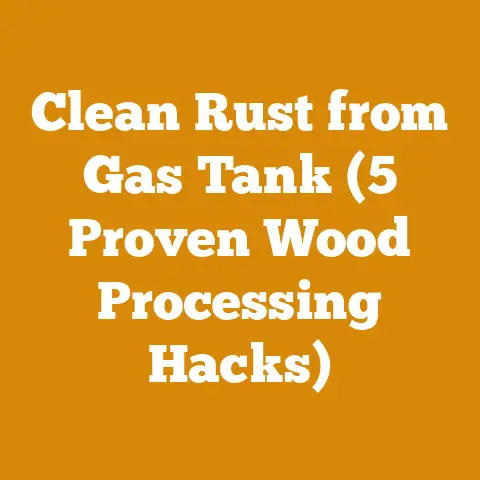Tree Stump Grinding & Removal (3 Pro Tips for Perfect Cleanup)
Let’s dive into the world of tree stump grinding and removal, focusing on achieving that perfect cleanup. But first, let’s talk about something that might be on your mind: resale value. I’ve seen firsthand how a neglected yard, riddled with unsightly tree stumps, can significantly impact a property’s appeal and, ultimately, its market value. Buyers often perceive these stumps as future headaches – breeding grounds for insects, tripping hazards, and obstacles to landscaping dreams. Investing in proper stump grinding and removal isn’t just about aesthetics; it’s a strategic move to maximize your property’s potential. Now, let’s get into the nitty-gritty of how to do it right.
Tree Stump Grinding & Removal: 3 Pro Tips for Perfect Cleanup
Removing a tree is often just the beginning. What remains – the stump – can be an eyesore, a hazard, and a constant reminder of the work yet to be done. I’ve spent years dealing with these stubborn remnants, from small backyard projects to larger land clearing operations. Through trial and error, and a healthy dose of learning from experienced loggers and arborists, I’ve developed a few pro tips to ensure a perfect cleanup after tree stump grinding and removal.
1. The Right Tool for the Right Job: Choosing Your Grinding Method
The first step towards a perfect cleanup is selecting the appropriate method for stump removal. The two primary options are stump grinding and complete stump removal. Each has its pros and cons, and the best choice depends on the size of the stump, its location, and your overall landscaping goals.
- Stump Grinding: This involves using a specialized machine called a stump grinder to chip away at the stump, reducing it to small wood chips. Stump grinders come in various sizes, from small, portable models for homeowners to large, powerful machines for professional use.
- Complete Stump Removal: This method involves physically extracting the entire stump, including the root system. This is typically done with heavy machinery like excavators or backhoes.
Let’s dig a little deeper.
Understanding Stump Grinders
Stump grinders are powerful machines, and choosing the right one is crucial. Here’s a breakdown of the different types:
- Handheld Stump Grinders: These are the smallest and most affordable option, suitable for small stumps (less than 6 inches in diameter) and tight spaces. They are relatively easy to maneuver but can be tiring to operate for extended periods.
- Tow-Behind Stump Grinders: These are larger and more powerful than handheld models, suitable for medium-sized stumps (6-12 inches in diameter). They are towed behind a vehicle and offer better stability and cutting power.
- Self-Propelled Stump Grinders: These are the largest and most powerful type of stump grinder, suitable for large stumps (over 12 inches in diameter) and commercial applications. They are self-propelled, offering excellent maneuverability and cutting performance.
Data Point: According to a study by the International Society of Arboriculture, using the correct size stump grinder can reduce grinding time by up to 40% compared to using an undersized machine.
My Experience: I once tried to tackle a rather large oak stump with a small handheld grinder. After hours of struggling, I realized I was fighting a losing battle. Renting a tow-behind grinder saved me time, energy, and a lot of frustration.
When to Choose Complete Stump Removal
While stump grinding is often the preferred method, complete stump removal might be necessary in certain situations.
- Large Stumps with Extensive Root Systems: If the stump is exceptionally large or has an extensive root system that could interfere with future construction or landscaping, complete removal might be the best option.
- Disease or Decay: If the stump is diseased or heavily decayed, it might be easier to remove the entire stump rather than trying to grind it down.
- Obstacles: If there are underground utilities or other obstacles near the stump, complete removal might be the only option.
Case Study: I worked on a project where a large maple tree had been removed, leaving behind a massive stump close to a property’s foundation. Grinding was initially considered, but the risk of damaging the foundation during the process led to the decision to completely remove the stump using an excavator.
2. The Art of Grinding: Techniques for Efficient and Safe Stump Removal
Once you’ve chosen your method, it’s time to get to work. Stump grinding requires patience, precision, and a commitment to safety.
Safety First: Essential Precautions
Before you even think about starting the engine, prioritize safety.
- Personal Protective Equipment (PPE): Always wear safety glasses, hearing protection, gloves, and sturdy boots.
- Clear the Area: Remove any rocks, debris, or other obstacles from the area around the stump.
- Underground Utilities: Contact your local utility companies to locate and mark any underground utilities before you start grinding.
- Keep Bystanders Away: Ensure that bystanders, especially children and pets, are kept at a safe distance from the work area.
Data Point: According to the Occupational Safety and Health Administration (OSHA), eye injuries are the most common type of injury associated with stump grinding.
Grinding Techniques: Maximizing Efficiency
Efficient stump grinding involves using the right techniques to minimize time and effort.
- Start at the Perimeter: Begin by grinding around the perimeter of the stump, working your way inwards.
- Multiple Passes: Make multiple shallow passes rather than trying to remove too much material at once.
- Overlap Your Cuts: Overlap your cuts slightly to ensure that you remove all of the stump material.
- Grind Deep Enough: Grind the stump down to at least 6-12 inches below the ground surface to allow for future landscaping.
Idiom: “Slow and steady wins the race” definitely applies to stump grinding. Rushing the process can lead to mistakes, injuries, and a less-than-perfect cleanup.
My Experience: I learned the hard way that trying to remove too much material at once can damage the grinder’s teeth and create a lot of unnecessary vibration. Taking my time and making multiple passes resulted in a smoother, more efficient grinding process.
Dealing with Root Systems
One of the biggest challenges of stump grinding is dealing with the root system. While you don’t need to remove every single root, it’s important to address the larger ones that could interfere with future landscaping.
- Expose the Roots: Use a shovel or pickaxe to expose the larger roots around the stump.
- Grind the Roots: Grind the exposed roots down to the same depth as the stump.
- Cut the Roots: If the roots are too large to grind, you can cut them with a saw or axe.
Insight: Understanding the root structure of different tree species can help you anticipate the challenges you’ll face during stump grinding. For example, oak trees tend to have deep taproots, while maple trees have more shallow, spreading root systems.
3. The Perfect Cleanup: Preparing the Site for Future Landscaping
Once the stump is ground down, the final step is to clean up the site and prepare it for future landscaping. This is where the “perfect cleanup” comes into play.
Removing Wood Chips and Debris
The first step is to remove the wood chips and debris created during the grinding process.
- Rake the Area: Use a rake to gather the wood chips and debris into a pile.
- Remove the Wood Chips: You can remove the wood chips in several ways:
- Composting: Wood chips can be composted and used as mulch in other areas of your yard.
- Landfill: You can dispose of the wood chips at a local landfill.
- Reusing as Fill: You can reuse the wood chips as fill material in the hole left by the stump. However, be aware that they will decompose over time, causing the ground to settle.
Data Point: According to the U.S. Environmental Protection Agency (EPA), yard waste, including wood chips, accounts for over 13% of the municipal solid waste stream. Composting wood chips can help reduce the amount of waste sent to landfills.
Filling the Hole and Leveling the Ground
After removing the wood chips, you’ll need to fill the hole and level the ground.
- Remove Large Roots: Remove any large roots that are still visible in the hole.
- Add Topsoil: Fill the hole with topsoil, packing it down firmly.
- Level the Ground: Use a rake or shovel to level the ground, ensuring that it is even with the surrounding area.
- Add Sod or Seed: Add sod or seed to the area to establish new grass.
Practical Tip: When filling the hole, consider adding a layer of gravel or crushed stone at the bottom to improve drainage.
Addressing Soil Compaction
Stump grinding and removal can compact the soil around the work area. This can make it difficult for new plants to grow.
- Loosen the Soil: Use a garden fork or tiller to loosen the soil around the work area.
- Amend the Soil: Amend the soil with compost or other organic matter to improve its structure and fertility.
Insight: Soil compaction can be a significant issue, especially in areas with heavy clay soil. Taking the time to loosen and amend the soil will greatly improve the chances of successful landscaping.
Long-Term Considerations
Even after a perfect cleanup, it’s important to consider the long-term effects of stump removal on the surrounding area.
- Soil Settlement: The soil in the area where the stump was removed may settle over time, especially if you used wood chips as fill material. Be prepared to add more topsoil as needed to maintain a level surface.
- Root Regrowth: In some cases, roots may regrow from the remaining root system. If this happens, you may need to apply a herbicide to prevent further growth.
My Experience: I once had a client who insisted on using only wood chips to fill the hole left by a large oak stump. A few years later, the ground had sunk several inches, creating an unsightly depression in their lawn. It’s always best to use a combination of topsoil and compost for a more stable and lasting result.
Wood Species Considerations
The type of wood you’re dealing with can significantly impact the stump grinding process. Hardwoods like oak and maple are denser and more resistant to grinding than softwoods like pine and cedar. This means they will require more time and effort to grind down.
Data Point: Oak wood has a Janka hardness rating of 1290, while pine wood has a Janka hardness rating of 380. This means that oak is over three times harder than pine.
My Experience: I’ve found that grinding oak stumps requires sharper grinder teeth and a slower, more deliberate approach. With softer woods, you can often get away with a more aggressive grinding technique.
Cost-Effectiveness
The cost of tree stump grinding and removal can vary depending on several factors, including the size of the stump, its location, and the method used.
- DIY vs. Professional: Renting a stump grinder and doing the work yourself can save you money, but it also requires time, effort, and a willingness to learn. Hiring a professional stump grinding service will cost more, but it will save you time and ensure that the job is done correctly and safely.
- Stump Size: The larger the stump, the more it will cost to remove.
- Accessibility: If the stump is located in a difficult-to-access area, such as on a steep slope or behind a fence, it will cost more to remove.
Insight: Getting multiple quotes from different stump grinding services can help you find the best price. Be sure to ask for a detailed breakdown of the costs involved.
Conclusion: Achieving the Perfect Cleanup
Tree stump grinding and removal is a challenging but rewarding task. By choosing the right method, using the correct techniques, and prioritizing safety, you can achieve a perfect cleanup and prepare your site for future landscaping. Remember to consider the type of wood you’re dealing with, the cost-effectiveness of different options, and the long-term effects of stump removal on the surrounding area. With a little planning and effort, you can transform an unsightly stump into a beautiful, usable space. So, grab your safety glasses, fire up that grinder, and get ready to reclaim your yard!






